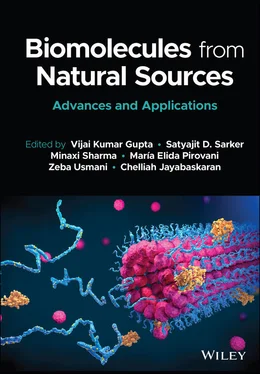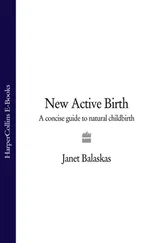Biomolecules from Natural Sources
Здесь есть возможность читать онлайн «Biomolecules from Natural Sources» — ознакомительный отрывок электронной книги совершенно бесплатно, а после прочтения отрывка купить полную версию. В некоторых случаях можно слушать аудио, скачать через торрент в формате fb2 и присутствует краткое содержание. Жанр: unrecognised, на английском языке. Описание произведения, (предисловие) а так же отзывы посетителей доступны на портале библиотеки ЛибКат.
- Название:Biomolecules from Natural Sources
- Автор:
- Жанр:
- Год:неизвестен
- ISBN:нет данных
- Рейтинг книги:5 / 5. Голосов: 1
-
Избранное:Добавить в избранное
- Отзывы:
-
Ваша оценка:
- 100
- 1
- 2
- 3
- 4
- 5
Biomolecules from Natural Sources: краткое содержание, описание и аннотация
Предлагаем к чтению аннотацию, описание, краткое содержание или предисловие (зависит от того, что написал сам автор книги «Biomolecules from Natural Sources»). Если вы не нашли необходимую информацию о книге — напишите в комментариях, мы постараемся отыскать её.
An up-to-date exploration of new and novel biomolecules Biomolecules from Natural Sources: Advances and Applications,
Biomolecules from Natural Sources: Advances and Applications
Natural Sources: Advances and Applications
Biomolecules from Natural Sources — читать онлайн ознакомительный отрывок
Ниже представлен текст книги, разбитый по страницам. Система сохранения места последней прочитанной страницы, позволяет с удобством читать онлайн бесплатно книгу «Biomolecules from Natural Sources», без необходимости каждый раз заново искать на чём Вы остановились. Поставьте закладку, и сможете в любой момент перейти на страницу, на которой закончили чтение.
Интервал:
Закладка:
199 199 Park, H., Kim, H., Kim, G.Y., Lee, M.Y., Kim, Y., and Kang, S. (2020). Enhanced biodegradation of hydrocarbons by Pseudomonas aeruginosa-encapsulated alginate/gellan gum microbeads. Journal of Hazardous Materials 406: 124752.
200 200 Rukmanikrishnan, B., Ismail, F.R.M., Manoharan, R.K., Kim, S.S., and Lee, J. (2020). Blends of gellan gum/xanthan gum/zinc oxide based nanocomposites for packaging application: rheological and antimicrobial properties. International Journal of Biological Macromolecules 148: 1182–1189.
201 201 Sriamornsak, P. (2011). Application of pectin in oral drug delivery. Expert Opinion on Drug Delivery 8 (8): 1009–1023.
202 202 Manjunath, M., Gowda, D.V., Kumar, P., Srivastava, A., Osmani, R.A., and Shinde, C. (2016). Guar gum and its pharmaceutical and biomedical applications. Advanced Science, Engineering and Medicine 8 (8): 589–602.
203 203 Patel, S. and Goyal, A. (2015). Applications of natural polymer Gum Arabic: a review. International Journal of Food Properties 18 (5): 986–998.
204 204 Balasubramaniam, S., Lee, H.C., Lazan, H., Othman, R., and Ali, Z.M. (2005). Purification and properties of a beta-galactosidase from carambola fruit with significant activity towards cell wall polysaccharides. Phytochemistry 66 (2): 153–163.
205 205 Teleman, A., Nordström, M., Tenkanen, M., Jacobs, A., and Dahlman, O. (2003). Isolation and characterization of O-acetylated glucomannans from aspen and birch wood. Carbohydrate Research 338 (6): 525–534.
206 206 Pasale, S.K., Cerroni, B., Ghugare, S.V., and Paradossi, G. (2014). Multiresponsive Hyaluronan-p(NiPAAm) “Click”-linked hydrogels. Macromolecular Bioscience 14 (7): 1025–1038.
207 207 Enrione, J., Díaz-Calderón, P., Weinstein-Oppenheimer, C.R., Sánchez, E., Fuentes, M.A., Brown, D.I., Herrera, H., and Acevedo, C.A. (2013). Designing a gelatin/chitosan/hyaluronic acid biopolymer using a thermophysical approach for use in tissue engineering. Bioprocess and Biosystems Engineering 36 (12): 1947–1956.
208 208 Esmonde-White, K.A., Le Clair, S.V., Roessler, B.J., and Morris, M.D. (2008). Effect of conformation and drop properties on surface-enhanced Raman spectroscopy of dried biopolymer drops. Applied Spectroscopy 62 (5): 503–511.
209 209 Figallo, E., Flaibani, M., Zavan, B., Abatangelo, G., and Elvassore, N. (2007). Micropatterned biopolymer 3D scaffold for static and dynamic culture of human fibroblasts. Biotechnology Progress 23 (1): 210–216.
210 210 Geissler, E., Hecht, A.M., and Horkay, F. (2007). Scaling equations for a biopolymer in salt solution. Physical Review Letters 99 (26): 267801.
211 211 Naskar, B., Ghosh, S., Nagadome, S., Sugihara, G., and Moulik, S.P. (2011). Behavior of the amphiphile CHAPS alone and in combination with the biopolymer inulin in water and isopropanol water media. Langmuir 27 (15): 9148–9159.
212 212 Dhanapal, V. and Subramanian, K. (2014). Recycling of textile dye using double network polymer from sodium alginate and superabsorbent polymer. Carbohydrate Polymers 108: 65–74.
213 213 Sukhlaaied, W. and Riyajan, S.-A. (2013). Synthesis and properties of carrageenan grafted copolymer with poly(vinyl alcohol). Carbohydrate Polymers 98 (1): 677–685.
214 214 Abd alFattah Amara, A. (2008). Polyhydroyalkanoates: from basic research and molecular biology to application. IIUM Engineering Journal 9 (1): 37–73.
215 215 Williams, S.F.a. and Martin, D.P. (2002). Applications of PHAs in medicine and pharmacy. In: Biopolymers, Vol. 4, Polyesters III; Applications and Commercial Products (ed. Y. Doi and A. Steinbüchel), 91–127. Germany: Wiley-VCH.
216 216 Anderson, A.J. and Dawes, E.A. (1990). Occurrence, metabolism, metabolic role, and industrial uses of bacterial polyhydroxyalkanoates. Microbiological Reviews 54 (4): 450–472.
217 217 Lageveen, R.G., Huisman, G.W., Preusting, H., Ketelaar, P., Eggink, G., and Witholt, B. (1988). Formation of polyesters by Pseudomonas oleovorans: effect of substrates on formation and composition of poly-(R)-3-hydroxyalkanoates and poly-(R)-3-hydroxyalkenoates. Applied and Environmental Microbiology 54 (12): 2924–2932.
218 218 de Koning, G.J.M., Kellerhals, M., van Meurs, C., and Witholt, B. (1997). A process for the recovery of poly(hydroxyalkanoates) from pseudomonads part 2: process development and economic evaluation. Bioprocess Engineering 17 (1): 15.
219 219 Lutke-Eversloh, T., Bergander, K., Luftmann, H., and Steinbuchel, A. (2001). Biosynthesis of poly(3-hydroxybutyrate-co-3-mercaptobutyrate) as a sulfur analogue to poly(3-hydroxybutyrate) (PHB). Biomacromolecules 2 (3): 1061–1065.
220 220 Lütke-Eversloh, T., Fischer, A., Remminghorst, U., Kawada, J., Marchessault, R.H., Bögershausen, A., Kalwei, M., Eckert, H., Reichelt, R., Liu, S.-J., and Steinbüchel, A. (2002). Biosynthesis of novel thermoplastic polythioesters by engineered Escherichia coli. Nature Materials 1 (4): 236–240.
221 221 Lütke-Eversloh, T. and Steinbüchel, A. (2003). Novel precursor substrates for polythioesters (PTE) and limits of PTE biosynthesis inRalstonia eutropha. FEMS Microbiology Letters 221 (2): 191–196.
222 222 Findlay, R.H. and White, D.C. (1983). Polymeric beta-hydroxyalkanoates from environmental samples and bacillus megaterium. Applied and Environmental Microbiology 45 (1): 71–78.
223 223 Byrom, D. (1987). Polymer synthesis by microorganisms: technology and economics. Trends in Biotechnology 5 (9): 246–250.
224 224 Jendrossek, D., Schirmer, A., and Schlegel, H.G. (1996). Biodegradation of polyhydroxyalkanoic acids. Applied Microbiology and Biotechnology 46 (5–6): 451–463.
225 225 Doi, Y. (1995). Microbial synthesis, physical properties, and biodegradability of polyhydroxyalkanoates. Macromolecular Symposia 98 (1): 585–599.
226 226 Marchessault, R.H. (1996). Tender morsels for bacteria: recent developments in microbial polyesters. Trends in Polymer Science 4: 163–168.
227 227 Gross, R.A., DeMello, C., Lenz, R.W., Brandl, H., and Fuller, R.C. (1989). The biosynthesis and characterization of poly(β-hydroxyalkanoates) produced by Pseudomonas oleovorans. Macromolecules 22 (3): 1106–1115.
228 228 Preusting, H., Nijenhuis, A., and Witholt, B. (1990). Physical characteristics of poly(3-hydroxyalkanoates) and poly(3-hydroxyalkenoates) produced by Pseudomonas oleovorans grown on aliphatic hydrocarbons. Macromolecules 23 (19): 4220–4224.
229 229 Son, H., Park, G., and Lee, S. (1996). Growth-associated production of poly-beta-hydroxybutyrate from glucose or alcoholic distillery wastewater by Actinobacillus sp. EL-9. Biotechnology Letters 18 (11): 1229–1234.
230 230 Kauffman, G.B. and Seymour, R.B. (1990). Elastomers: i. Natural rubber. Journal of Chemical Education 67 (5): 422.
231 231 Hocking, P.J. and Marchessault, R.H. (1994). Biopolyesters. In: Chemistry and Technology of Biodegradable Polymers (ed. G. Griffin), 48–96. Springer Netherlands.
232 232 Holmes, P.A. (1985). Applications of PHB – a microbially produced biodegradable thermoplastic. Physics in Technology 16 (1): 32–36.
233 233 Addison, C.J., Chu, S.H., and Reusch, R.N. (2004). Polyhydroxybutyrate-enhanced transformation of log-phase Escherichia coli. Biotechniques 37 (3): 376–378, 380, 382.
234 234 Knowles, J.C. (1993). Development of a natural degradable polymer for orthopaedic use. Journal of Medical Engineering and Technology 17 (4): 129–137.
235 235 Kunze, C., Freier, T., Kramer, S., and Schmitz, K.P. (2002). Anti-inflammatory prodrugs as plasticizers for biodegradable implant materials based on poly(3-hydroxybutyrate). Journal of Materials Science: Materials in Medicine 13 (11): 1051–1055.
236 236 Cheng, S., Chen, G.Q., Leski, M., Zou, B., Wang, Y., and Wu, Q. (2006). The effect of D,L-betahydroxybutyric acid on cell death and proliferation in L929 cells. Biomaterials 27 (20): 3758–3765.
Читать дальшеИнтервал:
Закладка:
Похожие книги на «Biomolecules from Natural Sources»
Представляем Вашему вниманию похожие книги на «Biomolecules from Natural Sources» списком для выбора. Мы отобрали схожую по названию и смыслу литературу в надежде предоставить читателям больше вариантов отыскать новые, интересные, ещё непрочитанные произведения.
Обсуждение, отзывы о книге «Biomolecules from Natural Sources» и просто собственные мнения читателей. Оставьте ваши комментарии, напишите, что Вы думаете о произведении, его смысле или главных героях. Укажите что конкретно понравилось, а что нет, и почему Вы так считаете.


![Джеймс Купер - Пионеры, или У истоков Саскуиханны [The Pioneers, or The sources of the Susquehannah]](/books/395797/dzhejms-kuper-pionery-ili-u-istokov-saskuihanny-t-thumb.webp)









